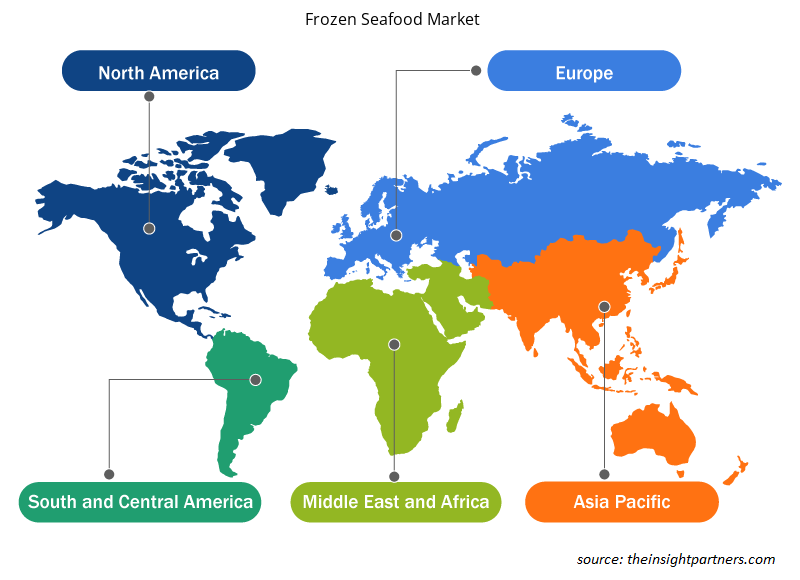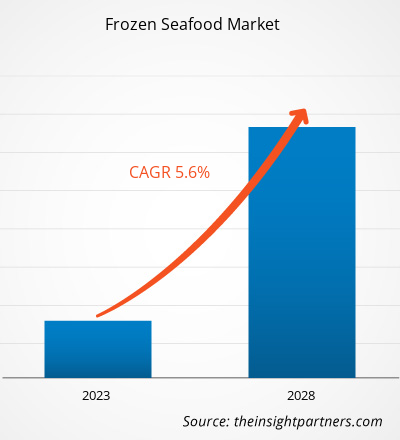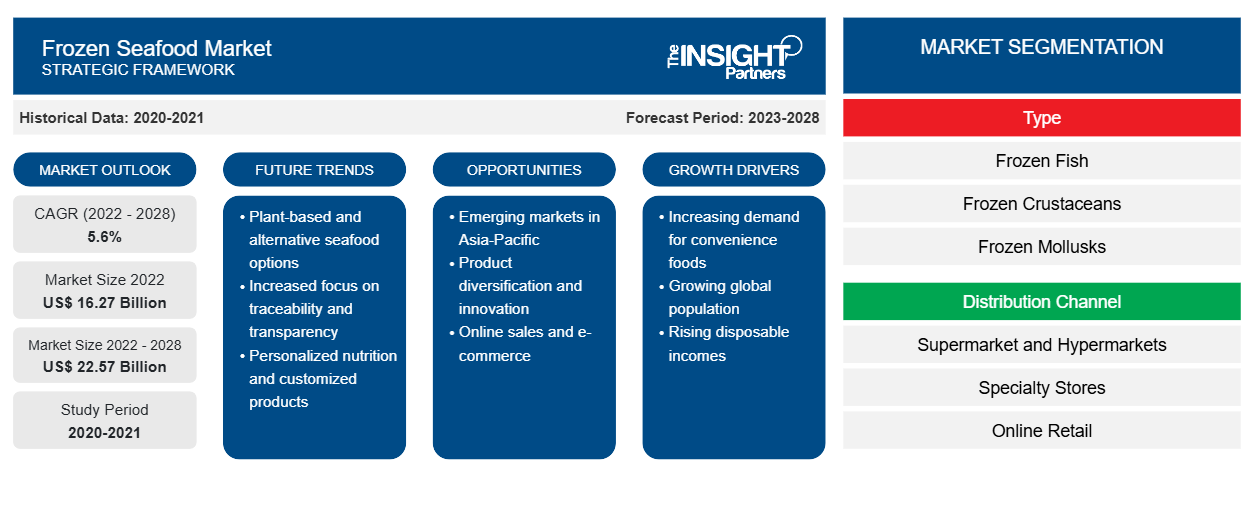Der Markt für tiefgekühlte Meeresfrüchte soll von 16,27 Milliarden US-Dollar im Jahr 2022 auf 22,57 Milliarden US-Dollar im Jahr 2028 anwachsen. Für den Zeitraum 2022–2028 wird mit einer durchschnittlichen jährlichen Wachstumsrate von 5,6 % gerechnet.
Die Nachfrage nach Tiefkühlfisch ist aufgrund des steigenden Gesundheitsbewusstseins der Verbraucher und des wachsenden Bewusstseins für die Vorteile des Verzehrs von Tiefkühlfischprodukten gestiegen. Die meisten Menschen führen heutzutage einen geschäftigen Lebensstil und möchten gesund leben. Tiefkühlfisch lässt sich bequem zubereiten und liefert wichtige Nährstoffe für den menschlichen Körper und das Gehirn. Darüber hinaus sind Tiefkühlfischprodukte günstiger und haben eine lange Haltbarkeit. All diese Faktoren werden voraussichtlich das Marktwachstum im Prognosezeitraum vorantreiben.
Aufgrund der starken Präsenz prominenter Akteure wie Thai Union Group, Sterling Seafood und Clifton Seafood Company, die weltweit aktiv sind, wird für die kommenden Jahre ein deutliches Wachstum des Marktes erwartet. Eine große Vielfalt an Tiefkühlprodukten mit Meeresfrüchten hat die Aufmerksamkeit der Verbraucher auf sich gezogen. Es gibt einen wachsenden Trend bei den Verbrauchern, abgepackte Lebensmittel zu konsumieren, was zu einem Wachstum des Marktes für Tiefkühlprodukte mit Meeresfrüchten geführt hat. Dieser Faktor wird den Herstellern von Tiefkühlprodukten mit Meeresfrüchten im Prognosezeitraum voraussichtlich neue Möglichkeiten bieten.
Im Jahr 2021 hielt der asiatisch-pazifische Raum den größten Anteil am globalen Markt für Tiefkühlfisch. Allerdings wird Nordamerika im Prognosezeitraum voraussichtlich die höchste durchschnittliche jährliche Wachstumsrate des Marktes verzeichnen. Der asiatisch-pazifische Markt ist in China, Indien, Australien, Japan, Südkorea und den Rest des asiatisch-pazifischen Raums segmentiert. Die Fischindustrie ist aufgrund der Verfügbarkeit und der gesundheitlichen Vorteile, die mit Meeresfrüchten verbunden sind, eine der boomenden Branchen im asiatisch-pazifischen Raum. Verbraucher in Entwicklungsländern erleben einen starken Anstieg ihres verfügbaren Einkommens, was ihre Kaufkraft erhöht. Verschiedene Fischprodukte, darunter auch Tiefkühlfischprodukte, verzeichnen einen Nachfrageschub. Das steigende verfügbare Einkommen der Verbraucher und das Wachstum der Mittelschicht sind einige der Schlüsselfaktoren, die die Nachfrage nach Tiefkühlfisch in der Region antreiben.
Passen Sie diesen Bericht Ihren Anforderungen an
Sie erhalten kostenlos individuelle Anpassungen an jedem Bericht, einschließlich Teilen dieses Berichts oder einer Analyse auf Länderebene, eines Excel-Datenpakets sowie tolle Angebote und Rabatte für Start-ups und Universitäten.
- Holen Sie sich die wichtigsten Markttrends aus diesem Bericht.Dieses KOSTENLOSE Beispiel umfasst eine Datenanalyse von Markttrends bis hin zu Schätzungen und Prognosen.
Auswirkungen der COVID-19-Pandemie auf den Markt für gefrorene Meeresfrüchte
Vor der COVID-19-Pandemie wurde das Wachstum des Marktes für Tiefkühlfisch vor allem durch die steigende Nachfrage nach Lebensmitteln mit hohem Nährwert vorangetrieben. Im ersten Quartal 2020 stand der Markt jedoch vor Hürden aufgrund von Betriebsschließungen sowie Rohstoff- und Arbeitskräftemangel. Die COVID-19-Pandemie führte in den ersten Monaten des Jahres 2020 zu einer Wirtschaftsrezession, die Verbraucher mit niedrigem und mittlerem Einkommen in finanzielle Schwierigkeiten brachte.
Darüber hinaus blieben die Menschen aufgrund der Einschränkungen zu Hause und kochten zu Hause, wodurch eine Nachfrage nach abgepackten Lebensmitteln entstand, die leicht zuzubereiten und qualitativ hochwertig sind. Die Verbraucher wurden zudem gesundheitsbewusster und bevorzugten Lebensmittel, die wichtige Nährstoffe lieferten, was das Marktwachstum während der COVID-19-Pandemie steigerte.
Markteinblicke
Vorteile des Verzehrs von gefrorenen Meeresfrüchten
Der Verzehr von gefrorenen Meeresfrüchten bietet verschiedene gesundheitliche Vorteile. Sie enthalten unter anderem Mineralien, Vitamine und Omega-3-Fettsäuren, die für den menschlichen Körper und das Gehirn unerlässlich sind. Sie verringern das Risiko von Herzinfarkten und Schlaganfällen, verbessern das Sehvermögen, behandeln Depressionen, verbessern die Gesundheit des Gehirns, verbessern die Haut- und Haarstruktur und stärken das Immunsystem. Das Einfrieren von Meeresfrüchten verlängert die Haltbarkeit von Meeresfrüchten und erhält die Qualität der Meeresfrüchte über einen längeren Zeitraum.
Gefrorene Meeresfrüchte sind in großer Auswahl erhältlich und die Menschen können je nach Bedarf aus einem großen Portfolio wählen. Sie sind außerdem bequem zuzubereiten und vermeiden Abfall.
Kategorie-Einblicke
Basierend auf dem Produkttyp ist der globale Markt in gefrorenen Fisch, gefrorene Krustentiere, gefrorene Weichtiere und andere unterteilt. Im Jahr 2021 hatte das Segment gefrorener Fisch den größten Umsatzanteil und wird im Prognosezeitraum voraussichtlich die höchste Wachstumsrate aufweisen. Eine typische Quelle für hochwertiges Protein ist Fisch. Fisch hat nicht nur einen höheren Gehalt an Omega-3-Fettsäuren und den Vitaminen D und B2 (Riboflavin), sondern enthält auch weniger Kalorien, gesättigte Fette und Cholesterin als andere Lebensmittel. Fisch ist nicht nur eine ausgezeichnete Quelle für Mineralien wie Eisen, Zink, Jod, Magnesium und Kalium, die den Blutdruck senken und das Risiko eines Herzinfarkts oder Schlaganfalls verringern können, sondern enthält auch viel Kalzium und Phosphor.
Thai Union Group, Sterling Seafood Corp., Clifton Seafood Company, Marine Foods, Viet Asia Foods Company, American Seafoods, Mazetta Company LLC, High Liner Foods Inc, The Sirena Group und Castlerock Fisheries Pvt. Ltd. sind die Akteure auf dem Markt. Diese Unternehmen bieten dem Markt ein breites Produktportfolio. Die Unternehmen sind in Entwicklungsregionen präsent und bieten lukrative Marktchancen. Die Marktteilnehmer entwickeln qualitativ hochwertige, innovative Produkte, um die Kundenanforderungen zu erfüllen.Viet Asia Foods Company, American Seafoods, Mazetta Company LLC, High Liner Foods Inc, The Sirena Group, and Castlerock Fisheries Pvt. Ltd. are the players operating in the market. These companies provide a wide range of product portfolios for the market. The companies have their presence in developing regions, providing lucrative market opportunities. Market players are developing high-quality, innovative products to meet customer requirements.
Regionale Einblicke in den Markt für gefrorene Meeresfrüchte
Die regionalen Trends und Faktoren, die den Markt für gefrorene Meeresfrüchte während des gesamten Prognosezeitraums beeinflussen, wurden von den Analysten von Insight Partners ausführlich erläutert. In diesem Abschnitt werden auch Marktsegmente und Geografie für gefrorene Meeresfrüchte in Nordamerika, Europa, im asiatisch-pazifischen Raum, im Nahen Osten und Afrika sowie in Süd- und Mittelamerika erörtert.

- Erhalten Sie regionale Daten zum Markt für gefrorene Meeresfrüchte
Umfang des Marktberichts über gefrorene Meeresfrüchte
| Berichtsattribut | Details |
|---|---|
| Marktgröße im Jahr 2022 | 16,27 Milliarden US-Dollar |
| Marktgröße bis 2028 | 22,57 Milliarden US-Dollar |
| Globale CAGR (2022 - 2028) | 5,6 % |
| Historische Daten | 2020-2021 |
| Prognosezeitraum | 2023–2028 |
| Abgedeckte Segmente | Nach Typ
|
| Abgedeckte Regionen und Länder | Nordamerika
|
| Marktführer und wichtige Unternehmensprofile |
|
Marktdichte von gefrorenen Meeresfrüchten: Auswirkungen auf die Geschäftsdynamik verstehen
Der Markt für gefrorene Meeresfrüchte wächst rasant, angetrieben durch die steigende Nachfrage der Endverbraucher aufgrund von Faktoren wie sich entwickelnden Verbraucherpräferenzen, technologischen Fortschritten und einem größeren Bewusstsein für die Vorteile des Produkts. Mit steigender Nachfrage erweitern Unternehmen ihr Angebot, entwickeln Innovationen, um die Bedürfnisse der Verbraucher zu erfüllen, und nutzen neue Trends, was das Marktwachstum weiter ankurbelt.
Die Marktteilnehmerdichte bezieht sich auf die Verteilung der Firmen oder Unternehmen, die in einem bestimmten Markt oder einer bestimmten Branche tätig sind. Sie gibt an, wie viele Wettbewerber (Marktteilnehmer) in einem bestimmten Marktraum im Verhältnis zu seiner Größe oder seinem gesamten Marktwert präsent sind.
Die wichtigsten auf dem Markt für gefrorene Meeresfrüchte tätigen Unternehmen sind:
- IFC Tiefkühl-Meeresfrüchte
- Sterling Meeresfrüchte
- Clifton Meeresfrüchte Unternehmen
- Meeresnahrung
- Vietnamesische Lebensmittel
Haftungsausschluss : Die oben aufgeführten Unternehmen sind nicht in einer bestimmten Reihenfolge aufgeführt.

- Überblick über die wichtigsten Akteure auf dem Markt für gefrorene Meeresfrüchte
Bericht-Spotlights
- Fortschrittliche Branchentrends auf dem Markt helfen den Akteuren bei der Entwicklung wirksamer langfristiger Strategien
- In Industrie- und Entwicklungsländern angewandte Strategien für Unternehmenswachstum
- Quantitative Analyse der Marktgröße für gefrorene Meeresfrüchteprodukte von 2020 bis 2028
- Schätzung der globalenNachfrage auf dem Markt für gefrorene Meeresfrüchte
- PEST-Analyse zur Veranschaulichung der Wirksamkeit der in der Branche tätigen Käufer und Lieferanten
- Aktuelle Entwicklungen zum Verständnis des wettbewerbsorientierten Marktszenarios
- Markttrends und -aussichten sowie Faktoren, die das Wachstum des Marktes für gefrorene Meeresfrüchte vorantreiben und bremsen
- Unterstützung im Entscheidungsprozess durch Aufzeigen von Marktstrategien, die das kommerzielle Interesse untermauern und zum Marktwachstum führen
- Die Größe des Marktes für gefrorene Meeresfrüchte an verschiedenen Knotenpunkten
- Detaillierte Übersicht und Segmentierung des Marktes sowie der Dynamik der Tiefkühlfischindustrie
- Marktgröße für gefrorene Meeresfrüchte in verschiedenen Regionen mit vielversprechenden Wachstumschancen
Die „Marktanalyse für gefrorene Meeresfrüchte bis 2028“ ist eine spezialisierte und eingehende Studie der Konsumgüterindustrie mit besonderem Schwerpunkt auf der globalen Trendanalyse des Marktes für gefrorene Meeresfrüchte. Der Bericht soll einen Überblick über den Markt mit detaillierter Marktsegmentierung bieten.
Der Markt für Tiefkühlfisch wird nach Art, Vertriebskanal und Geografie analysiert. Nach Art wird der globale Markt für Tiefkühlfisch in Tiefkühlfisch, Tiefkühlkrebse, Tiefkühlweichtiere und andere unterteilt. Nach Vertriebskanal wird der globale Markt für Tiefkühlfisch in Supermärkte und Hypermärkte, Fachgeschäfte, Online-Einzelhandel und andere unterteilt. Nach Geografie wird der Markt grob in Nordamerika, Europa, Asien-Pazifik (APAC), den Nahen Osten und Afrika (MEA) sowie Süd- und Mittelamerika unterteilt.
Firmenprofile
Thai Union Group, Sterling Seafood Corp., Clifton Seafood Company, Marine Foods, Viet Asia Foods Company, American Seafoods, Mazetta Company LLC, High Liner Foods Inc, The Sirena Group und Castlerock Fisheries Pvt. Ltd. sind die wichtigsten Akteure auf dem globalen Markt für tiefgekühlte Meeresfrüchte.
- Historische Analyse (2 Jahre), Basisjahr, Prognose (7 Jahre) mit CAGR
- PEST- und SWOT-Analyse
- Marktgröße Wert/Volumen – Global, Regional, Land
- Branchen- und Wettbewerbslandschaft
- Excel-Datensatz
Aktuelle Berichte
Verwandte Berichte
Erfahrungsberichte
Grund zum Kauf
- Fundierte Entscheidungsfindung
- Marktdynamik verstehen
- Wettbewerbsanalyse
- Kundeneinblicke
- Marktprognosen
- Risikominimierung
- Strategische Planung
- Investitionsbegründung
- Identifizierung neuer Märkte
- Verbesserung von Marketingstrategien
- Steigerung der Betriebseffizienz
- Anpassung an regulatorische Trends





















 Kostenlose Probe anfordern für - Markt für gefrorene Meeresfrüchte
Kostenlose Probe anfordern für - Markt für gefrorene Meeresfrüchte